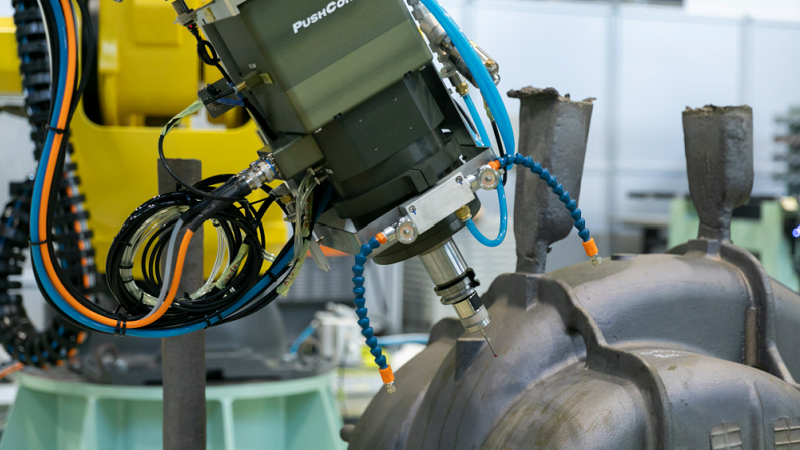Robotic Machining System Integrates Active Compliance and Touch Probe Technology
In the evolving landscape of industrial automation, precision and adaptability define the new frontier. Aichi Sangyo Co., Ltd., a Tokyo-based trading company known for importing and selling production equipment, has built its reputation not only on supplying advanced technologies but also on engineering comprehensive automation solutions.
The company’s Engineering Headquarters (Sagamihara Office) exemplifies this philosophy. Beyond trading in welding machines, machine tools, and metal 3D printers, it distinguishes itself through robotic systems integration, combining imported technologies with in-house engineering expertise to create high-value, turnkey automation solutions.
One particularly compelling example of Aichi Sangyo’s engineering capabilities is its robotic machining system that integrates the PushCorp Active Compliance Force Controller Device from the United States with METROL’s wireless 3D touch probe RC-K3X. This system offers a breakthrough approach to automating heavy-duty and hazardous manual operations such as cutting and grinding of large castings – tasks traditionally reliant on the skill and intuition of experienced workers.
Automation for the Next Generation of Manufacturing
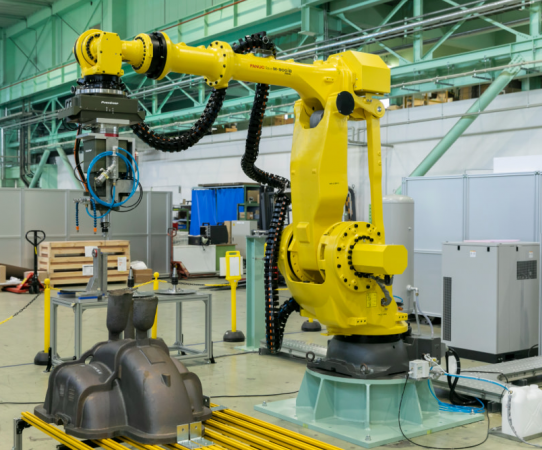
As Kotaro Takemoto, leader of the Mechanical Design Group in Aichi Sangyo’s System Manufacturing Department, explains: “We’ve always adapted flexibly to customer requests and the specific characteristics of each workpiece. Recently, there’s been a strong push for automation of large-scale machining and hazardous operations. Our goal is to build safe, consistent, and intelligent robotic systems.”
That push has been driven by pressing challenges. Large casting operations typically involve irregular workpiece shapes, unpredictable positioning, and manual alignment based on an operator’s visual judgment. This has led to persistent issues in safety, quality consistency, and productivity:
-
High risk due to manual handling of cutting tools and machinery
-
Inconsistent quality from human error and fatigue
-
Cumbersome handling of large, heavy parts
-
Long setup and changeover times
-
Difficulty supporting high-mix, low-volume production
With skilled labor in decline, traditional methods are increasingly unsustainable. Aichi Sangyo recognized that the solution lay in a smarter, sensor-driven approach – one that marries robotic control with precision metrology.
Combining Force Control and Touch Measurement
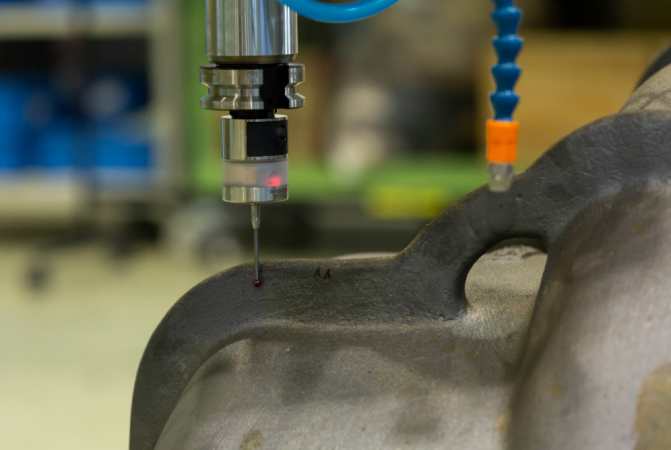
The solution developed by Aichi Sangyo integrates PushCorp’s Active Compliance Force Controller Device with METROL’s RC-K3X wireless touch probe to create an adaptive robotic machining cell capable of handling large, variably shaped castings.
The PushCorp device features a servo spindle with BT shank compatibility and a sliding mechanism equipped with force, acceleration, and position sensors. This allows the system to maintain constant contact pressure, compensating automatically for variations in robot trajectory or workpiece geometry.
Mounted on an industrial robot, the PushCorp unit can perform a variety of processes – cutting, grinding, polishing – while continuously regulating force feedback. The addition of METROL’s touch probe introduces an essential metrological layer, enabling the robot to detect, measure, and adapt before beginning the machining operation.
Step 1: Measuring and Position Correction with the Touch Probe
In traditional setups, heavy castings are positioned manually using cranes, and the exact placement is difficult to reproduce. Dedicated positioning jigs are often impractical for high-mix, low-volume production.
To solve this, Aichi Sangyo equipped the robot with METROL’s RC-K3X touch probe mounted in the PushCorp spindle’s BT shank. The robot first scans the workpiece surface by touching four key reference points. Based on the data, the system automatically calculates the workpiece origin and corrects its machining trajectory to account for positional deviations.
Step 2: Automated Cutting and Grinding
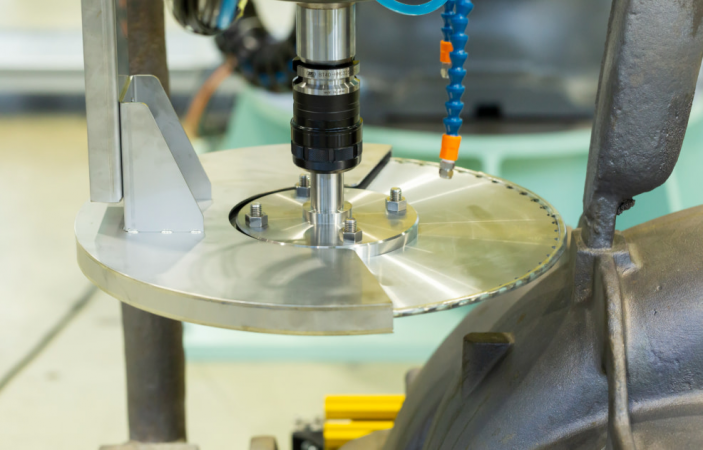
After measurement, the probe is replaced with a tip saw to cut off casting sprues – excess material remaining from the mold pouring process. The large iron casing in Aichi Sangyo’s example measured roughly one meter in all dimensions and housed the impeller of an LNG pump.
Once cutting is complete, the system automatically changes tools again, this time to an offset grinding wheel. A small machining allowance of about 10 mm is left to prevent overcutting. The robot then grinds and finishes the surface, maintaining optimal contact force through PushCorp’s active compliance control.
The result is a fully automated process – measuring, aligning, cutting, and finishing—all executed by a single robotic system.
The success of this automation system hinged on the choice of the right measurement device. Aichi Sangyo selected the METROL RC-K3X for several critical reasons including:
Reliable Wireless Communication: Robotic arms have high mobility and multiple axes of rotation, making cable management with wired probes cumbersome and risky. The RC-K3X’s wireless architecture, based on METROL’s proprietary communication method, provides stable, interference-resistant data transmission with 1 μm (2σ) repeatability, even in challenging industrial environments.
Contact Measurement Accuracy: Laser-based measurement systems, while fast, can struggle with reflective or rough metal surfaces typical of castings. The contact-type touch probe ensures accuracy independent of surface sheen or environmental lighting, delivering consistent metrology-grade data.
This tactile feedback also enhances the teaching process. “When fine-tuning programs, we often need to operate from outside the safety fence,” Takemoto explains. “The RC-K3X makes it easy to confirm physical contact with the workpiece visually and confidently.”
Expected Outcomes: Safety, Accuracy, and Adaptability
The integration of force-controlled robotics and touch probe measurement delivers transformative benefits:
Safety: Operators no longer handle cutting tools directly, reducing workplace hazards.
Setup Efficiency: Sensor-based measurement eliminates manual origin setting and reduces setup time dramatically.
Machining Accuracy: Automated position correction removes variability from human input, improving consistency.
Flexibility: The system adapts easily to different workpiece shapes and positions, supporting high-mix, low-volume manufacturing.
Skill Transfer: Automation reduces dependence on veteran craftsmanship, enabling easier scaling and training.
Future Prospects: From Weld Bead Finishing to Aerospace Applications
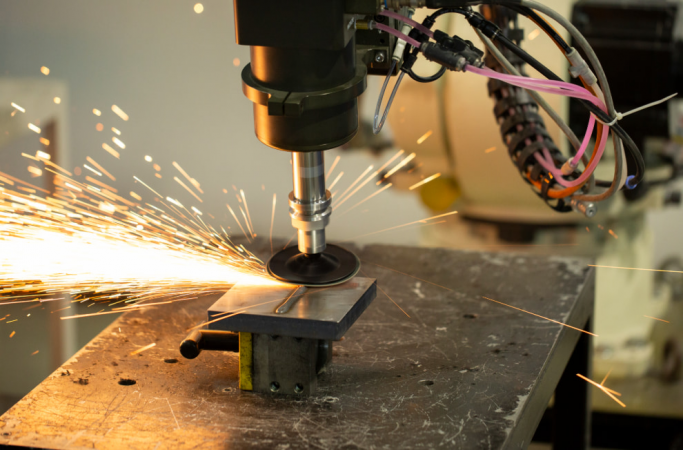
Aichi Sangyo envisions expanding this system’s use far beyond cast iron machining. “We haven’t yet fully utilized the RC-K3X’s repeatability of 1 μm,” Takemoto notes. “Our goal is to develop systems that can take full advantage of that capability.”
One promising application is post-weld finishing. When metals are welded, the joint often leaves a raised ‘weld bead.’ Using the PushCorp device, the robot can grind these beads to achieve a mirror-smooth surface. However, by first measuring bead height and width with the RC-K3X, the system could automatically optimize pressing force, reducing cycle time and improving surface uniformity.
This combination of pre-measurement and adaptive force control could be applied across a range of future manufacturing scenarios:
-
Weld bead finishing with precise, adaptive force optimization
-
Precision grinding of large aerospace or energy components
-
Fine surface finishing for materials that are difficult to machine
-
Automated scale removal and contour correction
Takemoto concludes, “We see great potential for the PushCorp and RC-K3X combination in any robotic cutting, machining, or grinding operation where precision has been the barrier to automation. We welcome new challenges in developing such systems.”
Future World Where Accuracy Meets Adaptability
The integration of metrology-based sensing and force-controlled robotics marks a pivotal shift in how complex machining and finishing tasks are automated. The system developed by Aichi Sangyo not only resolves long-standing challenges in casting and welding operations but also establishes a scalable model for precision automation in diverse manufacturing environments.
In a factory world where accuracy meets adaptability, Aichi Sangyo’s collaborative innovation with PushCorp and METROL sets a new benchmark for intelligent robotic machining – proof that metrology is no longer confined to inspection but is now an active enabler of production excellence.
For more information: www.metrol-sensor.com

